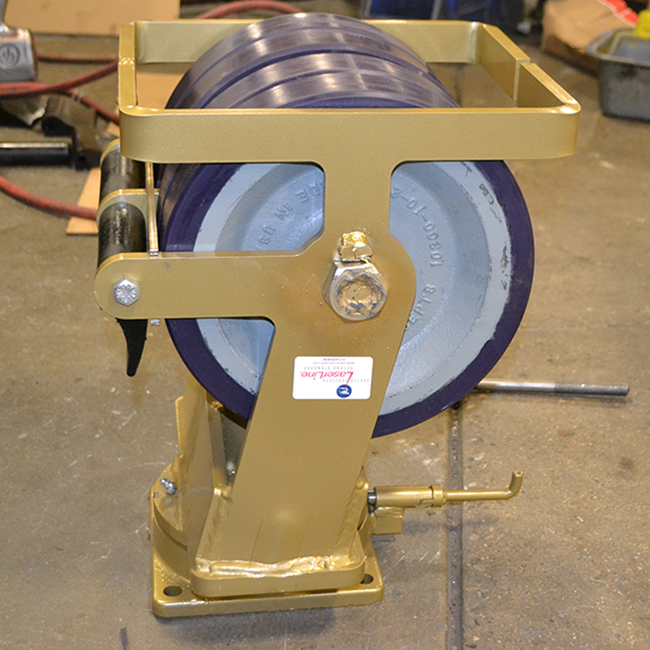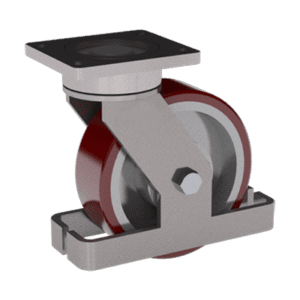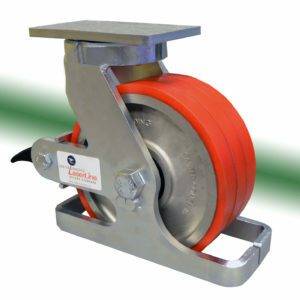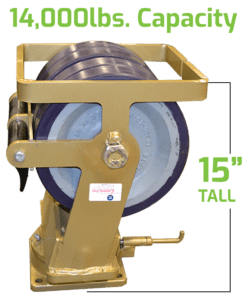

 A caster toe guard is an injury-prevention tactic. It is a protective barrier to protect people’s toes and feet, reducing injury claims and increasing caster safety. They are added to the metal caster rig at the initial assembly process. A steel press bends and shapes the steel to fit the toe guard around the caster.
A caster toe guard is an injury-prevention tactic. It is a protective barrier to protect people’s toes and feet, reducing injury claims and increasing caster safety. They are added to the metal caster rig at the initial assembly process. A steel press bends and shapes the steel to fit the toe guard around the caster.
As a general recommendation, toe guards are mounted 1/2 inch off the floor. This lets the casters move easily on the floor while keeping the cart operator’s feet from getting smashed. The guard can also accommodate different heights if necessary. This slightly raised height also allows the wheel to roll and swivel freely without making contact on uneven surfaces.
Toe guards are installed on many different sizes of casters. It fits with many other wheel materials and size options within the caster rig. They are becoming a common feature for facilities looking to limit injury claims
(including those that utilize AGVs) and the associated costs that come with them while improving overall workplace safety.
For example, in a study from the Bureau of Labor Statistics, three occupations with more than 40,000 injury cases had rates above 400 per 10,000 workers, with laborers and freight, stock, and material movers being one of the highest (466).

Twergo with toe guard and brake
Steel toe guards are typically preinstalled on the caster during production. However, if a customer decides to install a toe guard retroactively on an already existing caster to increase worker safety, that is accomplished with a demountable toe guard. In this case, the dimensions of the existing caster would be necessary. These measurements ensure that the demountable toe guard is the proper size for that installation.
Toe guards typically do not have explicit weight limits, as they are not load-bearing components. Their primary function is to provide a protective barrier to prevent toes or other objects from contacting the rotating caster wheel. However, having the correct load capacity of the caster is crucial.
The industry standard for mounting is for the guard to be ½” from the floor. This standard height aligns with the protection from steel-toe boots and is low enough to hit the sole of most sneakers. It also prevents the toe guard from riding up and over someone’s foot. The heavier the load and larger the caster wheel, the more critical worker safety concerns become.
In cases where a customer wants a softer material, plastic or nylon toe guards are typically used. The advantage of a softer material is that it allows the toe guard to take the damage from impacting a floor, even if the floor is so uneven that it collides with the guard. This way, this impact has limited or no damage to the flooring.
If your application requires toe guards and you are going up a ramp, you’ll want to measure to be sure that the ramp is not on enough of an incline that it prevents the casters from being able to roll up it.
The toe guard can also protect the caster itself from damage. Another useful purpose of a toe guard is to keep the caster from rolling over larger objects (think of it as a pseudo brush guard). This may allow these larger objects to be pushed out of the way and keep the caster, wheel, or even possibly the material being moved from taking damage.
For more information on the guards, additional accessories, or any of our material handling solutions, please get in touch with a Caster Concepts Representative. For immediate assistance, call 888-799-7166.